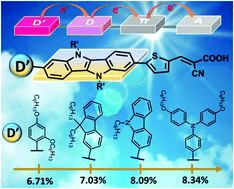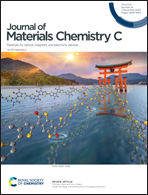Synergy effect of electronic characteristics and spatial configurations of electron donors on photovoltaic performance of organic dyes†
Abstract
Considering the key role of electron donors to the intramolecular charge transfer of organic dyes, molecular arrangement and electron processes in dye-sensitized solar cells, four organic dyes (LI-133–136) were designed and synthesized with indolo[3,2-b]indole (IDID) as the main electron donor and various aromatics as the assistant ones. The broad light response was achieved by the strong electron-donating ability of IDID with a planar structure, and with the aid of the electron-rich property of carbazole and triphenylamine. Moreover, the twisted configuration and large size of triphenylamine on the head of dye LI-136 can be beneficial to suppressing dye aggregation and electron recombination, contributing to the improved photovoltaic performance. With the systematic investigation of their photophysical and electrochemical impedance properties, together with theoretical calculations, the electronic characteristics of IDID and the spatial configuration of triphenylamine were highlighted as a synergy effect on the photovoltaic performance, affording an efficient strategy to simultaneously enhance the light-harvesting property and suppress the charge recombination.



 Please wait while we load your content...
Please wait while we load your content...